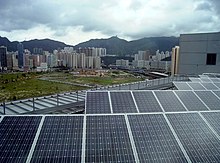Energy in Hong Kong


Energy in Hong Kong refers to the type of energy and its related infrastructure used in Hong Kong. Energy is crucial for the development of trade and industries in Hong Kong with its relatively small usable land.[1] Hong Kong mostly imports its energy from outside or produces it through some intermediate process.[2]
Energy sources[]

Coal[]
Most of the imported coal to Hong Kong are mainly used for electricity generation. Indonesia was the major supplier of steam coal and other types of coal imported to Hong Kong in recent years which accounted for 94.5% of total coal imports in 2012.[2]
Natural gas[]
Natural gas was firstly introduced for electricity generation in Hong Kong in 1996.[3]
Nuclear[]
Hong Kong has no indigenous supply of nuclear energy and there is no nuclear power station in the territory. However, Hong Kong has imported electricity from Mainland China from the Daya Bay Nuclear Power Plant in Shenzhen, Guangdong since 1994.[3]
Hydro[]
Hong Kong has one hydropower plant in Tuen Mun coupled with a water treatment plant, but otherwise lacks rivers with significant flow to generate hydropower.
Oil[]
Oil products imported to Hong Kong have always mostly come from Singapore. Singapore accounted for 75.8% of fuel oil imports and 75.4% of unleaded motor gasoline imports. Mainland China and Macau are the two largest destination for oil products re-exporting from Hong Kong.[4]
Solar[]

Hong Kong has been using solar energy over the past 20 years. As of 2013, there is a 1 MW installed capacity of photovoltaic at Lamma Power Station, doubling its size from 550 kW since its first commissioning in July 2010.[5]
Wind[]

Hong Kong has a very small scale of wind power generation since early 2006, which is the Lamma Winds at Lamma Island with an installed capacity of 800 kW. In March 2013, HK Electric has just completed the full-year wind measurement for a proposal of offshore wind farm project in Southwest Lamma Island.
Regulatory body[]
Energy-related affairs are regulated by the Electrical and Mechanical Services Department (EMSD; Chinese: 機電工程署) under the Development Bureau of the Government of Hong Kong.
Companies[]
Energy-related companies of Hong Kong are:
- China Resources Petroleum Company Limited
- CLP Group
- The Hong Kong and China Gas Company
- Hongkong Electric Company
- Kunlun Energy
- SS United Group Oil & Gas Company
- Towngas China
Education[]
Energy-related education centres in Hong Kong include:
See also[]
References[]
- ^ "Energy & Our Environment". GovHK. Retrieved 21 April 2014.
- ^ a b http://www.statistics.gov.hk/pub/B11000022012AN12B0100.pdf
- ^ a b "HKNIC - Why Nuclear for Hong Kong". Hknuclear.com. Retrieved 21 April 2014.
- ^ "Hong Kong Energy Statistics" (PDF). Census and Statistics Department. p. 20. Retrieved 4 December 2019.
- ^ "HK Electric Investments - Press Releases". Hkelectric.com. 15 May 2013. Retrieved 21 April 2014.
- ^ "Archived copy" (PDF). Archived from the original (PDF) on 7 April 2014. Retrieved 2 April 2014.CS1 maint: archived copy as title (link)
- ^ "Archived copy" (PDF). Archived from the original (PDF) on 13 February 2015. Retrieved 2 April 2014.CS1 maint: archived copy as title (link)
- Energy in Hong Kong